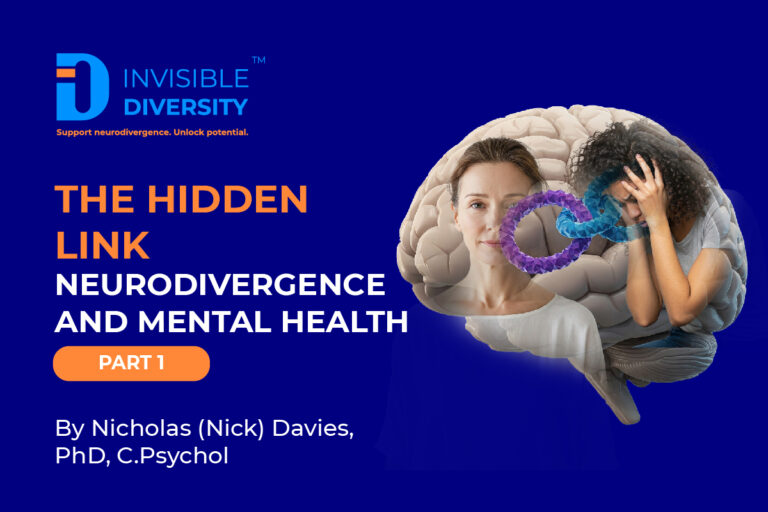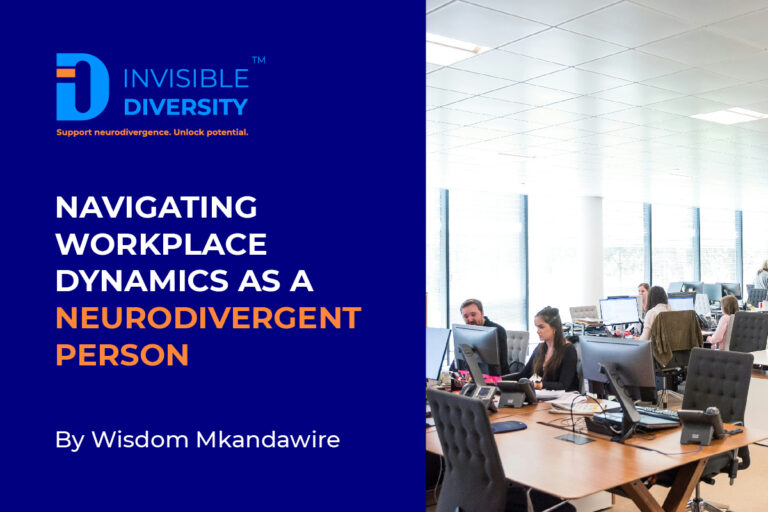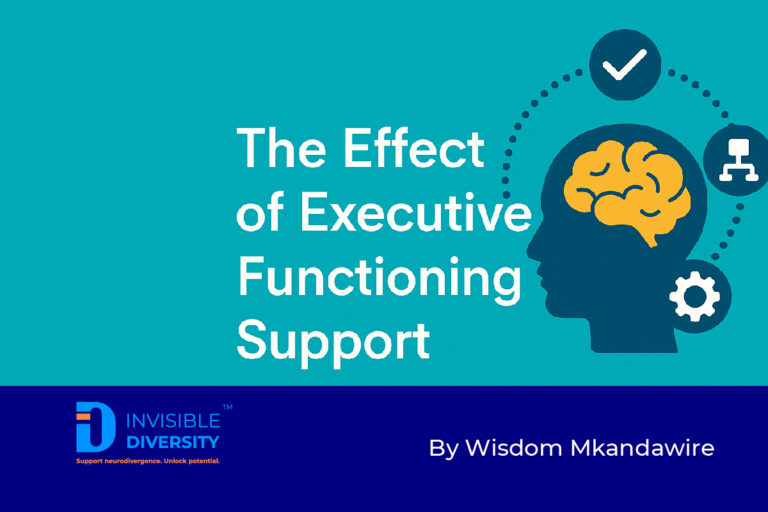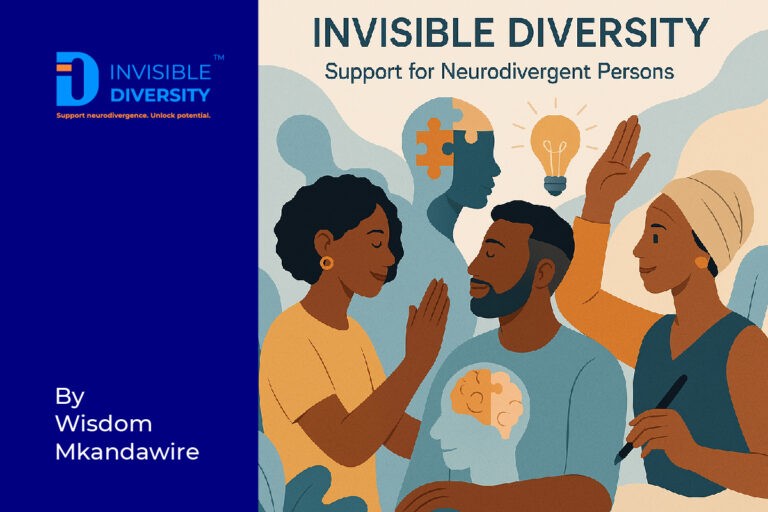blog posts

Optimizing Results with an Abundant and Growth Mindset
In a world that often emphasizes scarcity and competition, adopting an abundant and growth mindset can be transformative, both personally and professionally. These mindsets not only enhance our well-being but

An invisible diversity
I was in a meeting recently and as the discussion rapidly evolved, I wanted to contribute my perspective too. However, I could not find an entry point into the conversation

The Hidden Link: Neurodivergence and Mental Health (Part 1)
When we talk about neurodivergence—the natural variation in how human brains are wired—autism and ADHD often take centre stage. Autistic and ADHD individuals bring unique strengths to teams, such as creative problem-solving, deep focus, and innovative thinking. They offer fresh perspectives that can enhance collaboration and foster new ideas. However, these differences can sometimes lead to challenges, particularly when it comes to navigating mental health. Anxiety and mood disorders, for instance, are common companions for many neurodivergent individuals. Studies consistently show that neurodivergent people have a higher likelihood of developing mood or anxiety disorders with the disabling barriers of neurotypical society a significant factor. Regarding prevalence, one study found that the lifetime prevalence of anxiety disorders among adults with autism spectrum disorder (ASD) is 42%, while 37% will experience a depressive disorder. By contrast, the prevalence of anxiety disorders in the general U.S. adult population is around 18%. Autism and Anxiety: A Complex Relationship While anxiety, depression, and mood disorders frequently co-occur with autism, the reasons behind this connection aren’t always obvious. It’s easy to trivialize or normalize these struggles with statements like, “We all feel anxious sometimes.” But this isn’t about everyday anxiety or occasional low mood. For many autistic individuals, anxiety is deeply rooted in their neurology and context-specific experiences. Research highlights that autistic people often experience anxiety in unique ways. Unlike “everyday anxiety,” autism-specific anxiety can stem from uncommon phobias—such as fears of facial hair or toilet seats—or from social confusion, obsessive worries about losing access to a special interest, or irrational fears that a partner might abandon them. This anxiety arises from uniquely autistic contexts and experiences, reflecting valid responses to specific situations that may not be immediately understood by others. The Neurological Roots of Anxiety in Autism A deeper explanation lies in the brain’s structure and function. The amygdala, often called the brain’s “threat detector,” plays a key role in processing fear and emotional responses. In many autistic individuals, the amygdala is significantly more active than in non-autistic people, making them more sensitive to perceived threats. Imagine your brain’s alarm system being on high alert all the time—it’s exhausting and leaves you constantly on edge. A long-term study by the UC Davis MIND Institute found that alterations in the amygdala are associated with anxiety development in autistic children. This research supports the existence of autism-specific types of anxiety. Additionally, research funded by the National Institutes of Health suggests that difficulty processing sensory information during infancy can stress the amygdala, leading to its overgrowth. This overgrowth is implicated in autism-related symptoms. Another important factor is the hypothalamic-pituitary-adrenal (HPA) axis, which regulates the body’s stress response. When functioning properly, the HPA axis helps manage everyday challenges by releasing cortisol, the stress hormone. However, for many neurodivergent people, the HPA axis is overactive, flooding the body with cortisol and keeping it in a state of chronic hyperarousal. This heightened stress response makes it difficult to cope with sensory or social demands and can quickly escalate into overwhelming anxiety or panic-like symptoms. Brain Connectivity and Anxiety Communication between different brain regions also plays a crucial role in anxiety. Neurodivergent brains often exhibit either hyperconnectivity or hypoconnectivity. One study suggests that hyperconnectivity in the salience network—a system that detects and prioritizes relevant stimuli—may be a distinguishing feature in children with autism. The salience network’s association with the amygdala helps regulate the autonomic nervous system and physiological arousal. This hyperconnectivity may explain why autistic individuals perceive their environment as more threatening, leading to heightened arousal and anxiety. That said, many autistic individuals develop effective strategies to manage these responses, such as using structured routines, sensory tools, or mindfulness practices to reduce stress and improve emotional regulation. Information Processing Differences Autism is also associated with unique information processing styles. One model suggests that autistic brains process information sequentially—one piece at a time—while neurotypical brains process information in parallel, taking in multiple pieces simultaneously. A helpful analogy is assembling a puzzle (take a Rubic’s cube, for example, where each block represents a discrete piece of data): when entering a new environment, a neurotypical person receives the ordered Rubic Cube with all sides matching (all sensory data ordered and connected), and can immediately grasp the full context. In contrast, an autistic person receives a ‘jumbled’ Rubic’s Cube, and must engage in significant cognitive effort and time to order and re-order the discrete data until it all correctly lines up and an ‘un-jumbled’ Rubic’s cube (the whole picture) is accessed. This prolonged period of uncertainty can naturally lead to anxiety and stress. Autistic individuals often seek structure, familiarity, and predictability because these elements reduce the need to process new information spontaneously. Uncertainty is a significant driver of anxiety, and autistic people may experience it far more frequently than neurotypical individuals. ADHD and Anxiety While this blog focuses primarily on autism, ADHD also contributes significantly to heightened anxiety. Executive function difficulties, for example planning, organizing, regulating emotions can make everyday tasks feel chaotic and overwhelming. Worrying about how much—or how little—you’ve accomplished, missing deadlines, forgetting important details, or struggling to maintain focus can all fuel anxiety over time. Other Neurodivergent Conditions and Anxiety The connection between neurodivergence and anxiety extends beyond autism and ADHD. For example, individuals with dyslexia, dyscalculia, or dysgraphia may experience anxiety due to the expectations and pressures of the social environment. These individuals often carefully avoid situations that might expose their differences, further reinforcing feelings of anxiety. Looking Ahead In our next blog, we’ll explore the link between neurodivergence and depression, shedding light on another important aspect of mental health for neurodivergent individuals.

Unlocking Hidden Potential: The Case of Susan Boyle and Neurodivergent Talent
One of the thrills of watching the “X-factor” and “America Got Talent” type of programmes is the unexpected brilliance that jumps out when it’s least expected. What’s also interesting is how our unconscious and hidden biases play into either our disappointment or thrill of the performers. Way back in 2009 there was one of those moments of unconscious bias and stereotyping that temporarily obscured the extraordinary potential of one of the contestants. Susan Boyle, a then-unknown autistic Scottish woman, stepped onto the stage of Britain’s Got Talent. From the moment she introduced herself, her unconventional demeanour, offbeat humour, and social awkwardness caused the audience and judges to dismiss her. As the camera panned across audience members and then the judges, eye brows were raised, brows furrowed, and irreverent titters were heard. Looks of scepticism and ridicule were captured on camera. But then Ms Boyle broke into song – I dreamed a Dream from Les Miserables. As the beauty and power of her pitch perfect and sublime voice captivated the room, turning mockery into awe within seconds, eye brows rose again, jaws dropped and the audience burst into spontaneous applause with a standing ovation within 20 seconds of her starting. The judges revelled in the exquisiteness of her performance. Ms Boyle went onto a music career that was unparalleled success in both the UK and the USA. How does one capture what happened that day at the BGT auditions in Glasgow? What a transformative lesson on the dangers of underestimating people based on surface impressions. One can’t but reflect how Susan Boyle’s story exemplifies the frequently overlooked or unrecognized potential in neurodivergent individuals, and how societal prejudices and society’s “Tyranny of Shoulds” – she should look like this; she should dress like this; she should interact like this – can prevent us from providing the opportunity for neurodivergent persons to have an opportunity to use their talents, to contribute, to be their best self. Just for a moment, imagine if that BGT audition of Ms Boyle’s had been an interview for a formal job – Would she have got the job? Of course, it depends on the job and so on, but the point is, if for a moment we think of all the Susan Boyle’s out there, with talents, skills and valuable contributions to make, who present in idiosyncratic, non-normative ways, who’s answers to questions don’t fit the template for what we expect, what’s the outcome of their job interviews? Think of Ms Boyle’s answer to the question of her age, so unexpected and perhaps even bemusing; think of her lack of polished social skills, on the day…. Both totally irrelevant in terms of her singing prowess. Do our interview processes frequently disqualify the ‘operatic virtuoso’, because their answer to a question unrelated to the job description is out of our realm of comprehension, because their social engagement is not what we expect? Should there be a disqualification? Of course not, certainly not on those grounds. Fortunately, the winds of change are beginning to blow. Some might say it’s still only a light breeze and there is much still to be done in altering “normative” interview processes to not discriminate against difference. Nevertheless, there are many websites offering very practical guidance in changing interview processes to accommodate neurodivergence. Could we strengthen the breeze of change by not only including these practical suggestions in the interview process, but perhaps ensure there is a neurodivergent person as part of the interview process? This might not always be possible, but educating (rather than ‘training’) managers and HR persons about neurodivergence, helping them develop a deep understanding of the neurodivergent brain and how it impacts one’s way of being and presenting in the world – why some neurodivergent people don’t make eye-contact, prefer not to shake hands, why some neurodivergent persons struggle to spontaneously answer questions, needing time to process, why some neurodivergent persons might not laugh at the joke, or engage in the small talk at the start of the interview – could ensure that opportunities to contribute, self-actualise and be one’s best self are not denied those who appear different. Susan Boyle’s story resonates, I think, because it defied expectations and exposed how societal biases can obscure the brilliance of neurodivergent individuals. If Susan Boyle’s journey teaches us anything, it’s that the world loses out when it fails to see beyond the surface. By fostering inclusivity and supporting neurodivergence, we can uncover the hidden potential that lies within those who think and present differently. Let’s dream a dream of a world where every individual, regardless of how they present, has the experience of feeling safe, accepted and competent.

Navigating workplace dynamics as a neurodivergent person
Navigating workplace dynamics as a neurodivergent person A little over two years ago I decided to write to my professional community that I identify as a neurodivergent person. Since then, I have been on a journey to understand the workplace, my role in it and what I (and people like me) might need to thrive. My life has been significantly transformed. It has become my mission to embrace neurodiversity and share what I have learned with other neurodivergent professionals. I have even founded (along with Nick (Nicholas) Davies, PhD, C.Psychol (BPS)) Invisible Diversity, a social enterprise dedicated to empowering neurodivergent professionals in the workplace while raising awareness about and advocating for neuro-inclusion in society in general. Today, I share my personal experiences and insights on how to thrive in the workplace while embracing neurodiversity. Virtual office dynamics are a labyrinth of unspoken rules, hidden agendas, and intricate power dynamics. For neurotypical individuals, it’s already a complex enough dance, but for neurodivergent professionals such as autistics, the challenges can be significantly amplified! In the 2024 neurodiversity research by Neurodiversity in Business (NiB) – the Neurodiversity Charity founded by Dan Harris FRSA; and Birbeck University reported that navigating workplace dynamics is one of the top three challenges faced by neurodivergent workers. As someone who identifies as autistic, I’ve learned that understanding and navigating these dynamics requires both self-awareness and strategic finesse. The Autistic Perspective You see, autistic individuals often possess unique strengths such as attention to detail, intense focus, and unwavering dedication. However, these traits can clash with the unwritten norms of virtual office life. Some of the common challenges faced by autistic professionals include: Other Strategies for Success Fear not, it is not all doom and gloom – there are some simple strategies I’ve employed to help craft a work culture and space that is more conducive to neurodivergent persons’ success: Navigating virtual office dynamics as an autistic professional is a journey of resilience and growth. Embrace your neurodivergence, seek understanding, and remember that your unique perspective adds tremendous value to the workplace. By combining self-awareness with strategic adaptation, you can thrive in any organisational landscape. Remember, you’re not alone, my friend. Many neurodivergent professionals have faced similar challenges and emerged stronger – you too can play to win and craft a workplace set up for your success! Disclaimer: The views expressed in this article are solely those of the author and do not represent any specific organisation or group.

The Effect of Executive Functioning Support
As I was ruminating on a message for the dyslexia awareness week* (last week), I got reminded of an exceptional television series called “Monk” which I used to watch a few years ago. The TV show Monk** was created by Andy Breckman and first aired in 2002, on the USA Network. The show ran for eight seasons, concluding in 2009. It stars Tony Shalhoub as Adrian Monk, a brilliant detective with OCD who solves crimes while dealing with his own personal challenges. Detective Adrian Monk, a brilliant investigator with Obsessive-Compulsive Disorder (OCD), is the embodiment of neurodivergent excellence in the detective world. His assistant, Natalie Teeger, complements his unique skill set, making their duo an exceptional example of how embracing neurodiversity can lead to success. Monk’s keen attention to detail, driven by his OCD, allows him to spot clues that others often miss. He meticulously analyzes every aspect of a crime scene, uncovering hidden connections and solving cases that baffle others. His neurodivergence becomes his superpower, transforming his perceived limitations into unparalleled strengths. Natalie, on the other hand, is Monk’s grounding force. She provides emotional support and practical assistance, helping Monk navigate social interactions and manage his anxieties. Her patience and understanding create a safe environment where Monk can thrive. She also steps in when Monk’s OCD becomes overwhelming, allowing him to focus on his detective work without distraction. Together, their compatibility highlights the power of embracing and supporting neurodivergent individuals. Here are some practical examples of how their dynamic can be applied to other neurodivergent people in real life: Applying the Chief of Staff Model The Chief of Staff model, typically applied to CEO and senior executive roles, can also be adapted to improve the effectiveness of neurodivergent talent in leveraging their unique abilities. 1. Executive Functioning Support: A Chief of Staff provides executive functioning support, managing tasks, prioritizing responsibilities, and facilitating decision-making processes. For neurodivergent individuals, this role can help them navigate their work environment more effectively, allowing them to focus on their strengths and contributions. 2. Strategic Collaboration: By acting as a strategic collaborator, the Chief of Staff ensures that neurodivergent individuals are integrated into team projects and initiatives. This model promotes inclusion and maximizes the unique perspectives and problem-solving skills that neurodivergent individuals bring to the table. 3. Personalized Assistance: Similar to Natalie’s role for Monk, a Chief of Staff can offer personalized assistance tailored to the specific needs of neurodivergent individuals. This support can range from organizational help to emotional backing, ensuring that neurodivergent talent thrives in their roles. 4. Empowering Neurodivergent Talent: The Chief of Staff model empowers neurodivergent individuals by providing a stable support system that enhances their productivity and innovation. This approach not only benefits the individuals but also enriches the organization’s overall performance. Enhancing Effectiveness with Technology and AI The use of technology and artificial intelligence (AI) can significantly enhance the effectiveness of both neurodivergent individuals and their right-hand partners, improving partnership outcomes. AI-driven tools can automate routine tasks, manage schedules, and provide reminders, reducing the cognitive load on neurodivergent individuals. Advanced analytics can help identify patterns and strengths in their work, enabling better task allocation and support. Additionally, AI can facilitate communication and collaboration by providing real-time language translation, sentiment analysis, and adaptive interfaces tailored to individual needs. By integrating technology and AI, the partnership between neurodivergent talent and their companions can become more efficient, productive, and harmonious. By embracing neurodiversity and adapting the Chief of Staff model, organizations can unlock the full potential of neurodivergent individuals, leading to richer, more innovative, and compassionate communities. Contact Invisible Diversity via email [email protected]. * Dyslexia Awareness Week is observed annually during the first full week of October. This week aims to raise awareness about dyslexia, challenge common misconceptions, and highlight the unique experiences of individuals with dyslexia. ** Monk is an original creation by Andy Breckman, who also served as the head writer for the show. The character of Adrian Monk was inspired by various traits and characteristics, but he is entirely fictional.

Invisible Diversity: Support for Neurodivergent Persons
Supporting neurodivergent individuals involves fostering understanding, empathy, and inclusivity. Here are some ways society can better support them: Education and Awareness: Accommodations and Accessibility: Flexible Work Environments: Inclusive Hiring Practices: Mental Health Support: Social Inclusion: Advocacy and Representation: Remember, every person’s experience is unique, so individualized support is crucial.

Optimizing Results with an Abundant and Growth Mindset
In a world that often emphasizes scarcity and competition, adopting an abundant and growth mindset can be transformative, both personally and professionally. These mindsets not only enhance our well-being but also optimize our outcomes in various aspects of life. Here’s how everyone can leverage these powerful perspectives to maximize their potential. Embrace Possibilities An abundant mindset starts with the belief that there’s more than enough success, resources, and opportunities to go around. For me, as a neurodivergent person, this is particularly empowering. When combined with a growth mindset—the understanding that abilities and intelligence can be developed—this outlook becomes a catalyst for achievement. To optimize results, focus on possibilities rather than limitations. See challenges as opportunities to expand your capabilities and learn from every experience. Cultivate Generosity Generosity is a cornerstone of the abundant mindset. By sharing knowledge, resources, and time with others, you create a culture of reciprocity and collaboration. This approach not only benefits those around you but also comes back to enrich your own life. In the workplace, this could mean mentoring others or sharing credit for successes. As a neurodivergent individual, embracing generosity allows me to connect with diverse perspectives and enhance my learning process. Set Learning Goals With a growth mindset, the journey is just as important as the destination. Set learning goals alongside performance goals to ensure continuous development. For instance, if you’re aiming to increase sales, also set a goal to learn new sales techniques or understand customer behavior better. Personally, I continuously seek to improve my knowledge and capabilities, embracing every opportunity to learn and grow. In 2024, I undertook sales training to prepare myself for the entrepreneurial days ahead. Practice Resilience Resilience is key to maintaining a growth mindset in the face of setbacks. View failures as feedback rather than insurmountable obstacles. Analyze what went wrong, adjust your strategies, and try again with renewed insight. For neurodivergent individuals like me, resilience is often a natural trait, but it’s essential to consciously cultivate it to overcome challenges and thrive. Expand Your Network An abundant mindset encourages you to see the value in diverse relationships. Expand your network with individuals from various backgrounds and industries. This diversity can lead to new perspectives, ideas, and opportunities that you might not have encountered otherwise. As an autistic person, I thrive on learning from a vast array of sources and interactions, which enriches my understanding and adaptability. Reflect and Adjust Regular reflection allows you to assess whether your actions align with an abundant and growth mindset. Ask yourself if you’re approaching situations with openness and a willingness to learn. If not, consider what adjustments can be made to realign with these principles. For me, despite my autistic tendencies to be inflexible, intentional ongoing reflection is crucial to ensure I provide the most relevant and accurate information. By integrating an abundant and growth mindset into your daily life, you set the stage for enhanced performance, deeper relationships, and a richer life experience. Remember that these mindsets are not fixed; they require practice and commitment. However, the results—increased innovation, productivity, and fulfilment—are well worth the effort.